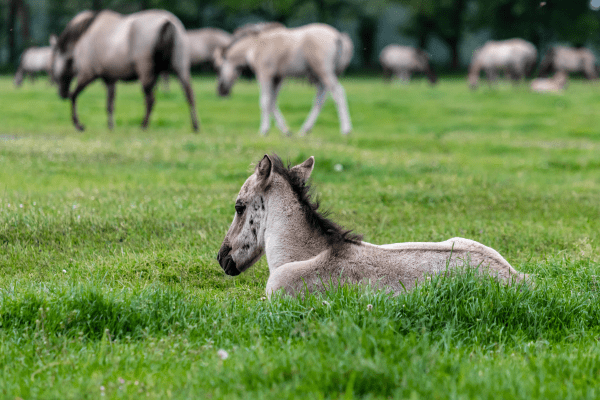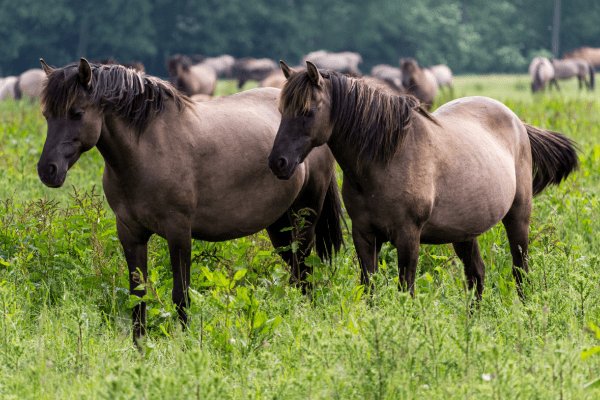The Dülmener pony, also known as the Dülmen, is a rare and distinguished breed of small wild horse native to Germany. Historically referred to as the Merfelderbrücher, this breed is steeped in a rich heritage yet faces a critical challenge in terms of survival. In 2014, the Dülmener garnered attention as the “endangered breed of the year,” a recognition that highlighted its precarious situation.
The concern for its future intensified when, in 2021, it was classified in category I, extrem gefährdet (extremely endangered), on the Rote Liste, a significant indicator of the breed’s urgent need for conservation and protection. This status not only reflects the breed’s current vulnerability but also emphasizes the importance of preserving a vital part of Germany’s equine biodiversity.
History:
The Dülmener pony, native to Germany’s Dulmen region, boasts a storied history that begins in the early 14th century. This narrative is not merely about survival; it’s a testament to resilience and natural adaptation over centuries.
Historical Beginnings: Originating in the 14th century, the Dülmener ponies initially faced significant challenges. They were subject to persecution, yet found a guardian in the Lord of Dulmen, who secured their protection and survival.
Primitive Ancestry: The breed exhibits traits indicative of a primitive origin. Noted equine author Bonnie Hendricks, in “The International Encyclopedia of Horse Breeds”, suggests a possible lineage from the wild Tarpan horse. However, this link remains an intriguing hypothesis, lacking definitive proof.
Feral Existence and Habitat Loss: Until the late 19th century, these ponies led a feral life in Germany’s Westphalia region. The division of land threatened their habitat, necessitating a relocation for their survival.
Relocation to Merfelder Bruch: The Dülmener ponies found a new sanctuary in the Merfelder Bruch, courtesy of the Dukes of Croy. This area, complete with essential resources like pastures and watering holes, allowed the ponies to continue their feral existence in a more secure environment.
Current Population: Today, around 300 Dülmener Ponies inhabit the Merfelder Bruch. This area, open to visitors during specific times of the year, allows the ponies to live in a natural state, foraging for food and shelter, and facing the challenges of the wild, including illness and natural selection.
Annual Tradition and Population Management: Each year, on the last Saturday of May, a unique tradition unfolds. The ponies are rounded up in an event that includes the public auctioning of foals. The mares and a few stallions are then released back into their habitat, a practice that helps manage the population and maintain the health of the breed.


Physical Characteristics:
Typically standing between 12 and 14 hands (48 to 56 inches) tall, Dülmener Ponies exhibit a robust and compact build. They have a distinctive mouse-grey color, often with a dark dorsal stripe and zebra-like leg markings, evidence of their primitive ancestry. Their thick manes and tails provide protection against the elements.
Versatility and Temperament:
Despite their wild upbringing, Dülmener Ponies are known for their calm and friendly demeanor, making them excellent companions for children and adults alike. They excel in various disciplines, from dressage and jumping to therapeutic riding, showcasing their versatility.
Conservation Efforts:
The breed faced near extinction during World War II but was saved by the efforts of local enthusiasts. Today, conservation efforts focus on maintaining genetic diversity and promoting sustainable breeding practices.
Breed enthusiasts and conservationists are working tirelessly to ensure these ponies continue to thrive, embodying a perfect blend of wild spirit and gentle nature.
The Dülmener Pony, with its rich history, resilience, and charm, offers a unique perspective on our relationship with the natural world. It reminds us of the importance of preserving nature’s wonders and the incredible bonds we can form with these magnificent creatures.
Symbol of Cultural Heritage:
The Dülmener Pony is more than just a breed; it’s a symbol of German cultural heritage and a testament to the harmony between humans and nature. These ponies are not just animals; they are storytellers, carrying the legacy of their land and people.



